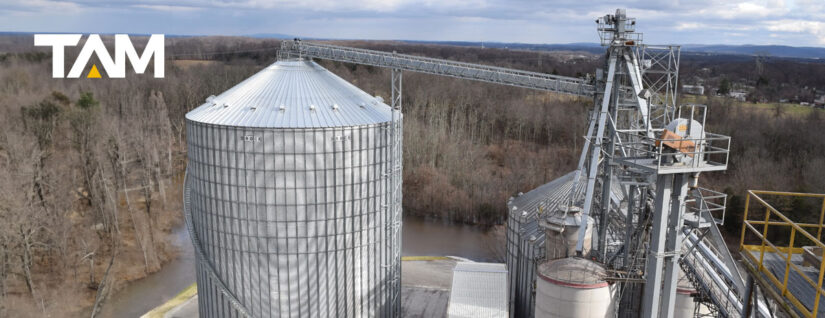Freshly harvested grains don’t have safe moisture content for long-term storage. As a farmer, you need to dry the grains if you want to prevent their deterioration and possible losses. You can use natural air drying to achieve the target safe storage moisture content. If you’re unfamiliar with this method, this article is an overview of the natural air-drying process or system used to dry grains.
What Is Natural Air Grain Drying?
Natural air drying uses unheated air to dry grain. Air drying typically happens in a storage container and dries the grain to 13% to 15% moisture. While standard drying methods use heat, natural air drying uses ambient or outdoor air moved through the grain with fans.
Natural air drying is also called:
- Ambient air drying
- Near-Ambient drying
- Unheated air drying
- Air drying
When air drying grain, air is allowed to pass through and around the grain to dry it. You can do this by exposing the grain to wind and ambient air, or you can use an agricultural drying system. If using a drying system, the grain is placed in aerated bins with controlled airflow and temperatures to ensure the grain is dried properly.
The air passing through the drying system must be humid enough to draw out the moisture from the grain but not too much to cause condensation on the grain. In addition, the controlled temperature should be low enough not to dry out or burn the grain and high enough to allow evaporation to occur. The airflow in the grain bin is controlled by the size and type of fans used and the resistance to airflow that is created by the grain. Each size and type of fan delivers a different airflow rate for similar bin conditions.
Importance of Proper Grain Drying
Drying plays a critical role in marketing the grain. Farmers should dry their grains using advanced drain dryers to get the best results. The benefits of effective grain drying include:
- Reduce mold: Drying reduces the grain’s water content, ultimately preventing the formation of harmful agents such as molds and aflatoxins. Proper grain drying protects the health of humans and animals.
- Safe storage: Proper grain drying reduces the risk of germination or degradation, making storing grain for longer periods possible. By preventing microbiological degradation, drying preserves the nutrients and maintains the grain’s economic value.
- Reduce waste: Effective grain drying also reduces product losses.
However, you should ensure the grains are not dried more than necessary. When grain is overdried, drying costs rise and the sales price decreases. Drying grain more than required removes water that would otherwise be sold. In addition, grain with large quantities of foreign materials should be cleaned before it’s mechanically dried to reduce the amount of energy used to dry the foreign materials.
Benefits of Natural Air Grain Drying System

Here are some of the advantages of using air-drying grain bins:
- Higher-quality grains: Natural air drying preserves the grain’s quality differently than other methods of grain drying, allowing it to maintain its flavor, texture, color and aroma.
- Low maintenance: Natural air drying requires only occasional care and maintenance.
- Cost savings: Air drying can be done without additional energy use or inputs.
Challenges of Natural Air Grain Drying
Natural air drying grain process also comes with some challenges:
- Lower capacity: This method of drying grain has a lower capacity compared to other methods, such as heat drying.
- Slowest method: Natural-air drying is the slowest grain drying method and poses the greatest risks for grain spoilage. In addition, it requires farmers to inspect the grain regularly for insect infestation and spoilage.
- Depends on weather: Natural air drying heavily depends on prevailing weather conditions and is not ideal for rainy seasons and winter.
Air Drying vs. Heat Drying
The main difference between heated drying and natural air drying is the temperature of the air. Natural air drying moves ambient, outdoor air through the grains, while heated drying systems use artificially heated air. Drying grain with ambient air in bins has several benefits, which we’ve already highlighted, such as low maintenance and higher quality grains.
Ambient air drying is mostly used for on-farm drying of small quantities of grain. However, this method of grain drying is not recommended for thick layers of grain with high moisture content. Ambient drying is only appropriate for grains with a maximum of 20% water content.
Natural air drying may last several weeks, depending on the weather conditions. Conversely, heated drying employs high temperatures for rapid grain drying, and the heat ends when the desired average moisture content is reached.
Hot air bin dryers can be classified according to grain flow type — recirculating, batch and continuous. Bins can also be classified as on-farm and off-farm dryers.
Recommendations for Natural Air Drying Success
To ensure the success of your natural air-drying system, follow these steps:
- Harvest grain at 22% moisture or less: Natural-air drying is a lengthy method compared to other drying systems, and grain above 22% may not dry quickly enough before it starts spoiling.
- Use the right storage bin: Your bin should have a fan capable of at least 2 cubic feet per minute (CFM) of airflow per bushel of grain.
- Install vents: For every 1,000 CFM of fan airflow, you should install at least 1 square foot of vents.
- Run fans continuously: The fans should run continuously to prevent the drying process from stalling.
- Fill the bins at 12-15 feet or less: Deeper grains in the bins create more back pressure, making the fans work harder and reducing the airflow.
If the grain does not fully dry by winter, little additional drying will occur during that cold season. Instead, cool the grain to below freezing and shut off the fans until warmer weather returns.
Explore Grain Drying Solutions With TAM Systems
Proper grain drying ensures you can store the product longer and avoid spoilage and losses. Whichever grain drying method you prefer to use, we can help you choose the right solution for your farm or grains. TAM Systems supplies on-farm grain storage, drying and conveying systems to give you complete control of your product during harvest. Learn more about our grain drying solutions, and let us know your needs.



